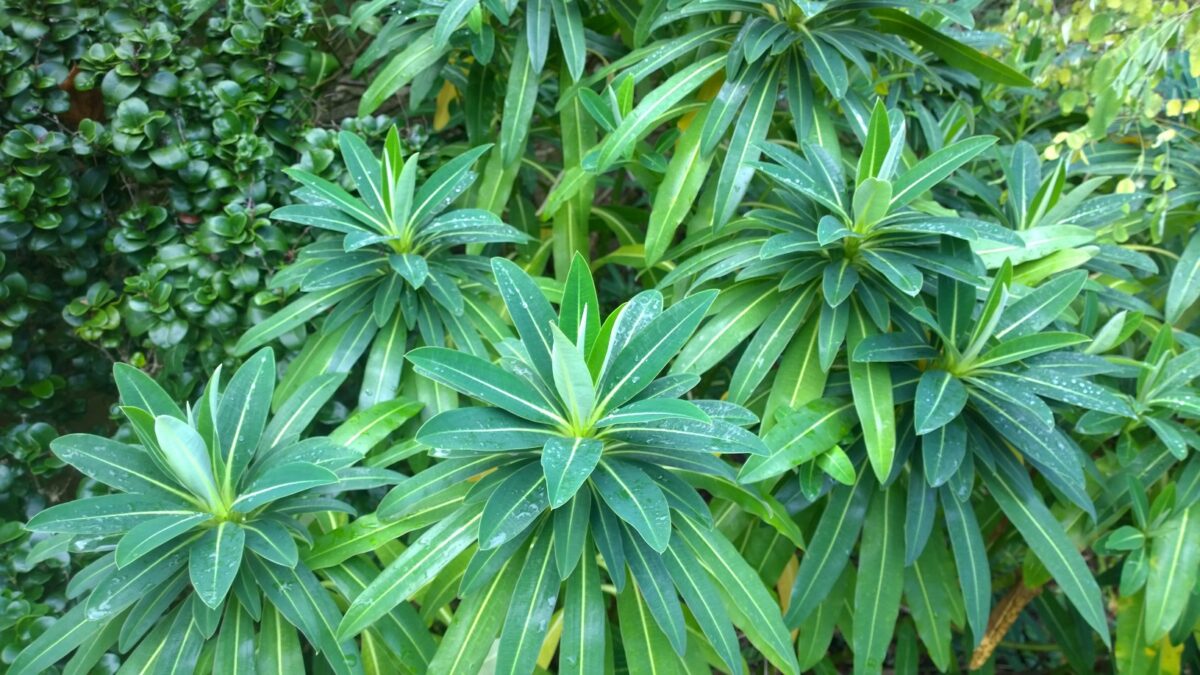
In the summer months, they are mostly background, but when winter comes, they are backbone.
From now on, evergreen shrubs become more and more important as the last remaining leaves of deciduous plants fall to earth.
Coloured stems, bare twigs, and silhouettes of trees, all play their part in the winter garden, as do the many highly scented flowers that come into their own as the new year unfolds; but right now, the evergreen shrubs hold centre stage, and none does it better than my special plant this week.
It is a truly garden–worthy plant: architectural, robust and vigorous, and being part child of E mellifera, it has the added bonus, in summer, of delicious honey scented flowers. It is however, different from E. mellifera in many respects: its foliage is a darker green with a strong, central, pale midrib, and it easily reaches 160 cms high and the same or more, across. Its second parent is E. stygiana an interesting but less vigorous euphorbia whose lower leaves turn brilliant red in winter; but this one has never really thrived on our cold dank clay, and seems to be asking to be returned to the Azores asap!
All we need now is a frost, which turns E x pasturii ‘John Phillips’ into a true winter wonder.
NB Louise has published a beautifully produced book of her plant profiles – A Plant for Each Week of the Year. It costs £9.99 and is for sale in our online shop here.
More NB If you’re not already a subscriber and you’d like a bit more gardening chitchat from the3growbags, please type your email address here and we’ll send you a new post every Saturday morning.

2 replies on “Euphorbia x pasteurii ‘John Phillips’ AGM”
I had both e.melliferra and e.passturi but lost them and left it for a year to see if the stumps would regrow but alas nothing. So my attention has been turned to a seedling that has grown up I’m sure it’s a pasturi now it’s flowering and I think that pasturi flowers well before melliferia. Any help would be welcomed. What ever happens proves that bringing my plants from Surrey to Wiltshire has produced plenty of casualties it’s a windy frost-pocket here in the pewsey vale.
Hello Alistair
Euphorbias in our garden here in Sussex took a real beating in the winter of 22/23 and I’d say that E mellifera proved to be the least hardy of those large shrubby types – I lost all my melliferas but found a few seedlings last summer. My E x pasteurii looked completely wiped out but started to shoot in the summer and is now regrowing happily. My E stygiana came through albeit battered, and it took almost a year for E x pasteurii ‘Phrampton Phatty’ to show signs of life!
So your seedling may well be from E x pasteurii if you found it in the vicinity of the parent plant, however, being a hybrid it may not come entirely true. Here’s an interesting link: https://panglobalplants.com/product/euphorbia-x-pasteurii-john-phillips/